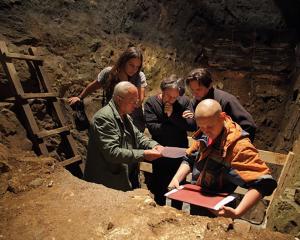New Zealand is trying to find its way back to grassroots community development, with Dunedin's Northeast Valley one of five government-funded trials nationally. It is an exciting but fraught business where not arriving at your original destination means you are probably on the right track, writes Bruce Munro.
Back on the island everyone knows everyone, Teakini Penaia (50) says.
Sitting in the dining room of his family's Northeast Valley rental home, the freezing worker, father of four and erstwhile university student is comparing life here with what they left in Tuvalu 11 years ago.
It is a sunny, spring morning. But tucked down a cul-de-sac on the shaded side of the valley, Mr Penaia has every reason to be wearing several layers topped by a jersey.
The climate, however, does not even rate a mention. The warmth he craves is of a different sort.
The decision to bring his family here for a better education has been a good one, he says.
He also values the friendships of two other Tuvaluan families in Dunedin and of members of the Pacific Islanders Presbyterian congregation whose church is a third of the way up North Rd, the valley's visual and physical spine.
But in Tuvalu, where there is your own land to grow food and ready access to fish, you do not have to worry so much about bills, he says. And back home there are always social events.
''There are lots of gatherings. And the people just love it,'' he says gazing out the window.
"Here, it is hard to get to know people.
''I miss that life. I hope to return to it one day.''
He is not the only one.
Throughout New Zealand, including in government circles, the tide is rising with a desire to see neighbourhoods once again creating their own strong and sustainable vibrant communities.
Insiders call it community-led development, or just CLD. It is the opposite of both individual apathy and top-down attempts to solve community ills.
It is what 60 years ago was simply called ''being neighbourly'', ''taking the bull by the horns'' and ''doing our bit''.
In the 21st century, however, it is an untried, risky but potentially better way of strengthening social fabric and building resilience in the face of increasing community fragmentation and looming economic and ecological uncertainties.
So the Department of Internal Affairs, having decided it should be able to get more bang for its $18 million-per-year community funding buck, has launched a trial of the community-led development approach.
Five communities have been selected for their high unemployment or low average income; sizeable Maori, Pacific Island or ethnic minority communities; multiple issues to address; strengths to build on; and current or potential leaders to spearhead the charge.
Northeast Valley was the only South Island community chosen. The other triallists are Whirinaki in Northland, Mount Roskill in Auckland, Mangakino, north of Taupo, and Cannons Creek/Waitangirua, east of Porirua.
The valley's story is its own. But it also mirrors changes and challenges many communities face.
Surveyed into 4ha blocks in 1846 and 1847, Northeast Valley was one of Dunedin's original suburban subdivisions, Gary Blackman, who grew up in the valley, says.
First settled by mostly middle-class agriculturists, it took on a more working-class appearance from the 1870s. Representative of those often self-employed blue-collar residents - but with a more colourful home life than most - was Henry Cox, who lived at Normanby, at the far end of the valley.
Mr Cox was an assistant draper who also grew grapes and tomatoes in commercial glasshouses on the sunny side of the valley, Mr Blackman says.
Mr Cox's unhappy married life came to an end in 1890 when his wife kept her promise to never return to their home if he insisted on leaving a party they were attending.
He then employed a housekeeper going by the name of Ida Bennett. Miss Bennett was a good housekeeper but was also adept at forgery and fraud on a grand scale. Eventually caught, she went to prison for three years.
But that was not the end of her criminal career. In 1909, Miss Bennett, whose real name was Amy Bock, became the colony's most infamous fraudster when she was arrested for masquerading as wealthy young gentleman Percy Redwood and marrying Agnes Ottaway, of Port Molyneux, South Otago.
For decades industries based in the valley, good public transport and expanding residential developments brought a steady stream of new families.
But when the baby-boomer children grew up and followed the jobs out of the valley, the old and cold houses they left behind were not so desirable to a new generation of young parents. Students drawn by low rents became increasingly common, bringing youth but not vested interest to the suburb.
At the same time, government policy formation and programme delivery was increasingly centralised, while traditional community leaders such as school principals, ministers and policemen were less likely to live in the neighbourhoods in which they worked.
It is a process Ray and Lynette Short have witnessed first-hand during 47 years living in the same house in Baldwin St.
The unofficial mayor and mayoress of the world's steepest street, the Shorts moved in at a time when taxis refused to go beyond their house because the then unsealed top half of Baldwin St was covered in stones the size of golf balls.
The couple can recount dozens of humorous and tragic accidents on their steep street, whose character has changed markedly, they say.
''It's much more, what would you say, cosmopolitan,'' Mrs Short says.
''When we first came here, everyone was from here. All that's changed now.''
Loud parties are evidence of the student population, although the Shorts have also noticed a small but significant increase in the number of young families.
Today, Northeast Valley has a resident population of about 4500. According to the 2006 census, the most recent data available, almost 80% are European and 7.3% are Maori. More than 9% and 3%, respectively, are Asian and Pacific Islanders, in both cases double the Otago average.
A third of valley dwellers class themselves as professionals, more than 11% are unemployed, and a quarter of families have one parent. The median income for those over the age of 15 is about $13,000, roughly half the Otago average.
Steve O'Connor says he took as much convincing as anyone when the department approached a group of valley residents three years ago offering to fund a $500,000-plus three-year community-led development trial.
There was already a history of community groups and government-funded programmes in the valley. It was not that long since the Northeast Valley Community Programme had merged with the more recent school-based Northeast Valley Community Development Project.
The project, with the support of Otago Youth Wellness Trust and Presbyterian Support Otago, had begun community development work in the valley but missed out on department funding, which was awarded to Brockville.
That application was still on the table when then Minister for the Community and Voluntary Sector Tariana Turia threw her support behind community-led development.
It was to be a new approach, local department officials told project members including Mr O'Connor, who is a project executive member and minister of the local Baptist church.
The funding would be an investment in enduring, integrated change rather than money for isolated projects and activities, they were told.
But Mr O'Connor was concerned ''lots of money often has lots of strings''. He was assured that would not be the case.
So in 2011 the Northeast Valley trial took its first steps, with the project given $10,000 to run public consultation meetings to ensure the development process was indeed community-led.
Community-led development is critical to the future wellbeing of New Zealand, Megan Courtney, of CLD advocates Inspiring Communities, says.
Ms Courtney, who is the Nelson-based co-convener of the national organisation, says the top-down approach, in which residents are passive recipients of services is neither successfully addressing local needs nor the big challenges the country faces, challenges such as climate change, food security, and child poverty and abuse.
"We have to build from strengths and assets - seeing our communities filled with assets and resources that can be leveraged, not just problems that outside experts need to be called in to solve,'' she says.
"Regenerating the 'can-do' community spirit is part of the ongoing community-building work to be done.''
Mr O'Connor thinks some members of government were at first hesitant about community-led development because it was a Maori Party initiative.''
But seeing it in action, they have warmed to it,'' he says.
Certainly Jo Goodhew, the current minister for the community and voluntary sector, has been talking up the trial, describing projects in Mt Roskill and Whirinaki as ''really exciting''.
In fact, community-led seems to be a bit of a buzzword in New Zealand and overseas.
The Wellington Region Emergency Management Office, for example, has recently been given an international award for its volunteer programme. The initiative is based on ''a new, community-driven emergency management philosophy'' which has replaced the old ''top-down, response-driven structure''.
In Northeast Valley the trial, in its second year, appears to be picking up a full head of steam.
More than $300,000 has been spent on employing community workers, buying two vans for the use of local organisations, and creating community rooms on a street-facing corner of Northeast Valley Normal School.
By the middle of next year a further $230,000-plus will have been spent on employment and projects. There will also be funding for the final year.
Certainly, some of the notable community-building activities in the valley - dinners, community garden working bees, the Valley Voice newsletter, Transition Valley 473's fruit tree planting and workshops, and the community choir - were already running before the trial began. But the project's executive now has a list of more than 40 projects that have been mooted, investigated or kick-started.
They range from well-attended Matariki celebrations at Dunedin North Intermediate School and a youth drop-in centre that is being set up in the Baptist church hall, to plans for mobile art exhibitions and a suggested networking event to encourage small business and manufacturing in the valley.
"Our philosophy is to go where the energy is,'' Mr O'Connor says.
"Often they are things that might have happened without the money, but are much enhanced by being able to put money to it.''
The trial is not without its challenges and potential problems.
Everyone getting their heads around community-led development was the first challenge.
''Even the department struggled a bit to know what it meant, because they were used to operating in a different way,'' Mr O'Connor says.
''How do you demonstrate and assess whether something is community led without strangling it?''
And the project's executive have had to make the leap from small-time operators to managers of big budgets, staff, and community expectations.
''We've had some good professional development input,'' Mr O'Connor says.
''Sure, there have been some niggles. But on the whole we've had consistent feedback from people about what they want, and there are good relationships ... between groups in the valley.''
The biggest threat he sees is the trial's ''small window of opportunity''.
''We've had to get up to speed quickly, and we also have to think about how to go down the other side.''
Of course, money on its own cannot turn passive residents into willing voluntary participants. Members of the project executive have various portfolios such as health, youth, business and education. But only some have volunteer teams to breathe life in to the long list of ideas and possibilities.
A community hui was held last month, in part to ''find more people to make things happen''.
And there is a danger that the money itself could get in the way.
Ms Courtney says community-led development does require the investment of effort, energy and money.
But she sounds a caution about large amounts of money in tandem with tight time frames, which can shift the focus from long-term planning to short-term shopping lists.
''Ironically, there is often more reason to collaborate when resources are stretched,'' Ms Courtney says.
''Scarcity encourages help-seeking and a call on the spirit of generosity and voluntary effort that can cement shared leadership around a common vision and locally led action.''
But it is almost inevitable that the community-led trial will be hailed a success in Northeast Valley, because the momentum has been growing since well before the trial began.
And nationally, because empowering people to find their own innovative solutions to create the sorts of communities they enjoy living in - even if the skills and processes take a while to be relearned - is, well, a no-brainer.
What is less certain, however, is what sort of place Northeast Valley will be at the end of this process. Not so much if community-led development does not really fly in the valley, but if it really takes off.
Dr Sean Connelly is a University of Otago sustainable community development researcher and, since February, a Northeast Valley resident.
Hailing from Canada, Dr Connelly said it was valley residents' ''sense of capacity and desire for change'' that drew him to live there.
Community-led development done well enables organisations, people and issues to interact openly and fully, Dr Connelly says.
Different viewpoints are seen, values are challenged and synergies become apparent.
It can be fraught with tension, and what emerges can be quite different from what was expected.
''That's one of the big differences of community-led development versus a top-down approach, it's more about the process than the outcomes.
''It's the process that builds the capacity to find innovative solutions.
''That's the real exciting part.''











